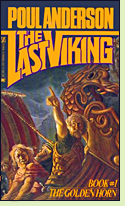The Golden Horn
by Poul Anderson
Reviewed by David Maclaine

The Golden Horn, the first volume in Poul Anderson’s trilogy The Last Viking begins with a prologue that offers a glimpse of its hero Harald Sigurdharson as a precocious three-year-old. At seventeen, Harald survives his first blooding on the battlefield where his older half brother Olaf the Stout dies, and then goes on to exile in Sweden, to Novgorod, to Kiev, and at last to Constantinople. In that great city, known to the Norse as Miklagardh, he grows to manhood as a member of the Varangian Guard, the corps of foreign mercenaries who guard the Byzantine emperor when not away on campaign against his enemies. Along the way Harald grows to the astonishing height of seven feet, becomes a successful war leader, and falls in love with a woman from a prominent Byzantine family. Entangled in the maneuvers for power that turned “Byzantine” into an adjective for complexity, he witnesses much of the folly that started the empire on its downward path. His thoughts keep returning to Norway, though, where he means to press his claim to the throne. By the end of this volume he has done just that, for this is the man who would become known as Harald Hardrede (more commonly spelled Hardrada), one of the three contestants in the events of 1066 that would transform English history.
The heart of the action in The Golden Horn takes place on the horn-shaped peninsula of Constantinople that gives the novel its name, and in the nearby Mediterranean lands where Harald wages war. The swiftly paced novel spares just enough time on character to make this eventful early phase of one of history’s most amazing life stories understandable to readers. (1980, 284 pages)
More about The Golden Horn at Amazon.comThe Golden Horn appears on the list of The 45 Best Historical Novels Set in the Viking Age
Other novels about warfare in Constantinople:
Crossed by Nicole Galland (2005), about the misadventures of a Welsh minstrel, a German knight, a prostitute and a mysterious princess during the Fourth Crusade. See review or more info at Powell's Books
The High City by Cecelia Holland (2009), about a traveler who draws the dangerous attention of Emperor Basil II amid a war between Basil and a potential usurper; #5 in the Soul Thief series. See review or more info at Amazon.com
Dark Angel by Mika Waltari (Finnish edition 1952, English translation 1953), about the Fall of Constantinople to the Ottoman Turks in 1453. See review or more info at Amazon.com
Nonfiction and original sources about Harold Hardrada:
King Harald's Saga by Snorri Sturluson (1966 Penguin edition), an English translation by Magnus Magnusson and Hermann Pálsson of the medieval Heimskringla. More info
Harold Hardrada: The Warrior's Way by John Marsden (2007). More info
The Varangians of Byzantium by Sigfus Blöndal (revised edition, 2007), a history of the Varangian Guard with particular emphasis on Harold Hardrada's role. more info
Online:
Real Men: Harald Hardrada at Manzine.org
Back to Novels of Scandinavia and the Vikings
Back to Directory of Book Reviews